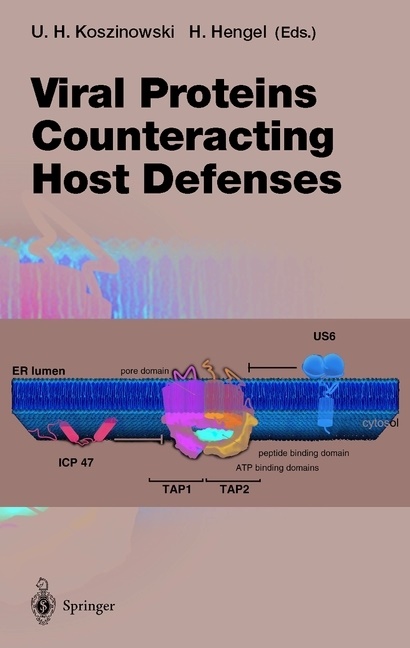Read more
Since the first observations of viral interference with antigen presentation in the MHC class-I pathway, the field has advanced to a detailed analysis. We know numerous genes and for some of them we have profound information on their mechanistic function. The antigen presentation pathway is affected at all stages starting from proteasomal degradation of an antigenic viral protein, as shown for EBV, transfer of the proteasomal cleavage products as peptides in the ER by specific transporters, the loading of the nascent MHC class-I molecule, and finally the transport of the complex to the surface and presentation in a normal or deranged form. All these different steps of the MHC class-I antigen presentation pathway are targets for viral proteins. Not only MHC class-I but also MHC class-II proteins are a target of viral influence either by direct downregulation and degradation of proteins or by interference of signal transduction pathways. Viruses that establish long-term or even lifelong infections have evolved sophisticated strategies to counteract a powerful host immune response. Bringing large DNA viruses like adenoviruses and herpesviruses into focus, this book documents a variety of such mechanisms, indicating a very active area of research over the last few years. The repertoire of viral mechanisms interfering with immune functions includes proteins that target antigen presentation pathways to prevent immune recognition or molecules mimicking soluble mediators ("virokines") or chemokine receptors. In view of the highly redundant immune effector mechanisms, the viral functions can teach us the relative biological significance of host defense strategies. Selected and optimized during evolution, the viral inhibitors now serve as unique tools which are perfectly designed to elucidate the molecular anatomy of the pathways that guide immune responses.
List of contents
List of Contents.- Strategies for the Identification and Analysis of Viral Immune-Evasive Genes - Cytomegalovirus as an Example.- Avoiding Proteasomal Processing: The Case of EBNA1.- The HCMV Gene Products US2 and US11 Target MHC Class I Molecules for Degradation in the Cytosol.- Corking the Bottleneck: The Transporter Associated with Antigen Processing as a Target for Immune Subversion by Viruses.- Herpes Viral Proteins Manipulating the Peptide Transporter TAP.- Herpes Viral Proteins Blocking the Transporter Associated with Antigen Processing TAP - From Genes to Function and Structure.- Inhibition of the MHC Class II Antigen Presentation Pathway by Human Cytomegalovirus.- Viral Evasion of Natural Killer Cells During Human Cytomegalovirus Infection.- Function of CMV-Encoded MHC Class I Homologues.- Human Cytomegalovirus Inhibition of Major Histocompatibility Complex Transcription and Interferon Signal Transduction.- Counteraction of Interferon-Induced Antiviral Responses by Herpes Simplex Viruses.- Immune Evasion Strategies of Kaposi's Sarcoma-Associated Herpesvirus.- Viral Chemokine Receptors and Chemokines in Human Cytomegalovirus Trafficking and Interaction with the Immune System.- Fatal Attraction: Cytomegalovirus-Encoded Chemokine Homologs.- Herpesviral Proteins Regulating Apoptosis.- Subversion of Host Defense Mechanisms by Adenoviruses.
Summary
Since the first observations of viral interference with antigen presentation in the MHC class-I pathway, the field has advanced to a detailed analysis. We know numerous genes and for some of them we have profound information on their mechanistic function. The antigen presentation pathway is affected at all stages starting from proteasomal degradation of an antigenic viral protein, as shown for EBV, transfer of the proteasomal cleavage products as peptides in the ER by specific transporters, the loading of the nascent MHC class-I molecule, and finally the transport of the complex to the surface and presentation in a normal or deranged form. All these different steps of the MHC class-I antigen presentation pathway are targets for viral proteins. Not only MHC class-I but also MHC class-II proteins are a target of viral influence either by direct downregulation and degradation of proteins or by interference of signal transduction pathways.

